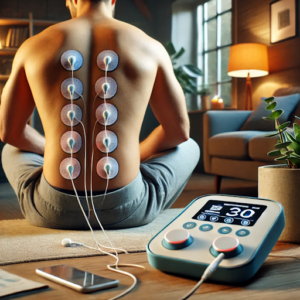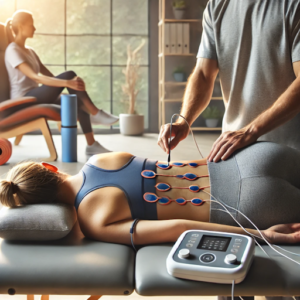Effectively Managing Back Pain Through Electrotherapy
Back pain is a widespread issue affecting millions worldwide, transcending age, gender, and lifestyle factors. It can manifest in various ways, from sharp discomfort lasting a few days to chronic pain that persists for months or years. Often, back pain stems from a combination of physical, psychological, and environmental factors.
Common causes of back pain include muscle strain, herniated discs, arthritis, and poor posture. The variability in how back pain is experienced complicates diagnosis and treatment. While some may find the pain tolerable, others could be severely debilitated, requiring a comprehensive approach from healthcare professionals.
Beyond physical health, chronic back pain can take a toll on emotional well-being, often leading to anxiety, depression, and social isolation. The economic implications are substantial, as back pain is one of the leading causes of disability and reduced productivity in workplaces.
Understanding the underlying causes of back pain is crucial for developing effective treatment strategies. One such strategy is electrotherapy, which has gained recognition for its ability to relieve pain and promote recovery.
Summary
- Back pain may result from factors like poor posture, muscle strain, or injury and significantly impact daily life.
- Electrotherapy is a non-invasive technique that uses electrical energy to manage pain and promote healing.
- Electrotherapy offers pain relief, muscle relaxation, improved circulation, and reduced inflammation.
- Different electrotherapy methods like TENS and EMS can help alleviate back pain.
- When using electrotherapy, it's important to follow healthcare professional advice and avoid using it near the heart or on broken skin.
 Introduction to Electrotherapy
Introduction to Electrotherapy
Electrotherapy refers to various techniques that use electrical energy to treat conditions like back pain. This therapeutic approach has evolved, utilizing advanced technologies to offer pain relief and promote healing. Electrotherapy can target specific areas of discomfort by stimulating nerves and muscles through electrical impulses.
Unlike medications, which may cause side effects or dependency, electrotherapy is non-invasive and effective in managing back pain. As research continues, the benefits of electrotherapy are becoming more widely recognized, leading to its integration into comprehensive pain management plans.
Benefits of Electrotherapy for Back Pain
One of the primary benefits of electrotherapy is its ability to provide immediate pain relief. Elect electrotherapy interrupts pain signals by sending electrical impulses to the affected area, reducing discomfort.
Additionally, it promotes the release of endorphins, the body's natural pain relievers, further enhancing its effectiveness. Electrotherapy also improves blood circulation and reduces inflammation, supporting the healing process. This combination of immediate and long-term benefits makes electrotherapy a valuable tool for managing back pain.
Types of Electrotherapy for Back Pain
Electrotherapy encompasses various methods, each targeting different aspects of back pain management. TENS (Transcutaneous Electrical Nerve Stimulation) is a popular technique that delivers low-voltage electrical currents to relieve pain. Its portability and ease of use make it ideal for home treatment.
IFC (Interferential Current Therapy) uses medium-frequency electrical currents to reach deeper tissues and address musculoskeletal issues. Additionally, EMS (Electrical Muscle Stimulation) and microcurrent therapy are increasingly recognized for stimulating muscle contractions and aiding tissue repair.
 How to Use Electrotherapy for Back Pain Management
How to Use Electrotherapy for Back Pain Management
Following specific guidelines is crucial to ensuring safety and effectiveness when using electrotherapy. Patients should consult a healthcare provider to determine the best electrotherapy option. Once a treatment plan is in place, therapy can be administered in a clinical setting or with portable devices at home.
Home users must follow the manufacturer's instructions for electrode placement, intensity, and session duration. A typical session lasts between 20 and 60 minutes. Consistency is key, as regular treatments offer cumulative benefits over time. Regular communication with a healthcare provider is essential to track progress and make adjustments if needed.
Precautions and Considerations When Using Electrotherapy
Although electrotherapy is generally safe, certain precautions should be taken to avoid complications. Individuals with heart disease, epilepsy, or implanted devices like pacemakers should consult a healthcare provider before using electrotherapy. Pregnant women are also advised to avoid electrotherapy near the abdomen or lower back.
It is important to avoid placing electrodes on open wounds or infected areas. Patients should also monitor their bodies for adverse reactions during treatment and stop immediately if they experience increased pain or skin irritation.
 Integrating Electrotherapy with Other Back Pain Management Techniques
Integrating Electrotherapy with Other Back Pain Management Techniques
Integrating electrotherapy with other treatments can enhance back pain management. A holistic approach often yields better results than relying on a single therapy. Combining electrotherapy with physical therapy can strengthen muscles and improve flexibility while addressing underlying musculoskeletal problems.
Making ergonomic adjustments at work or home can further enhance the benefits of electrotherapy by reducing strain on the back. Additionally, incorporating stress-reducing practices like yoga or meditation can help alleviate pain perception by promoting relaxation.
FAQs
Can you tell me about electrotherapy for back pain?
Electrotherapy uses electrical stimulation to manage and relieve back pain—standard methods in inStandardTENS and EMS.
How might electrotherapy help with my back pain?
Electrotherapy stimulates nerves and muscles to improve blood flow, promote healing, block pain signals, and trigger the production of endorphins, the body's natural painkillers.
Is it safe to use electrotherapy for back pain?
Electrotherapy is generally safe when guided by a trained healthcare provider. Follow recommended protocols and avoid applying the device near the head or heart.
How does electrotherapy work for back pain?
Electrotherapy relieves pain, reduces muscle spasms, and improves flexibility. It's a non-invasive and drug-free option for managing back pain.
Who can benefit from electrotherapy for back pain?
Electrotherapy may benefit individuals with conditions such as strained muscles, arthritis, sciatica, or herniated discs as part of a broader pain management strategy.
Are there any situations where electrotherapy isn't recommended?
Electrotherapy is not recommended for individuals with pacemakers, epilepsy, or heart conditions. Consult a doctor before starting treatment.
Brought To You By: Back Pain Therapy
The Article: Managing Back Pain with Electrotherapy appeared first on https://mcrtherapies.co.uk
The Article Managing Back Pain with Electrotherapy appeared first on https://mcrtherapies.com
The Article Managing Back Pain with Electrotherapy Was Found On https://limitsofstrategy.com


Your exploration of back pain as not only a physical ailment but also a complex interplay of emotional and social factors resonates deeply. As someone who has dealt with chronic back pain for years, I can attest that the mental toll—such as anxiety about my physical limitations and the potential isolation it brings—can be just as debilitating as the pain itself.
It’s really interesting that you mention the mental toll of chronic back pain; it’s something that doesn’t always get enough attention in conversations about physical health. The interplay of emotional and social factors can indeed amplify the experience of pain. I’ve seen how anxiety about physical limitations can lead to a cycle where the mind exacerbates what the body is feeling, making it harder to break free from that cycle.
You raise an important point about the emotional side of chronic back pain. It’s frustrating how often the mental aspects are overlooked. When someone is dealing with physical struggles, the mind has a way of fixing on that. Concerns about limitations can cloud even simple daily activities, leading to a cycle that seems almost impossible to escape.
You’ve highlighted a really crucial aspect of living with chronic back pain. It’s fascinating how our minds and bodies are interconnected in that way. When someone is anxious about their physical limitations, it can feel like a heavy weight, not just on their back but on their entire outlook on life. I’ve seen how people often get trapped in a feedback loop where their worry about pain can lead to inactivity, which in turn can heighten the pain experience.
You’ve really captured the complexity of that mind-body relationship. It’s interesting how that feedback loop you mentioned can be so challenging to break. I’ve noticed in my own experience, and in conversations with others, that sometimes just the fear of moving can be paralyzing. It’s not just about the physical pain; it’s this mental barrier that feels just as real.
I totally relate to your thoughts on the mind-body connection; I recently read something that dives into how red light therapy might offer some relief for chronic back pain, which could really help break that cycle of worry and inactivity.
‘“Back Pain Relief with Red Light Therapy Techniques”’
https://soonrs.com/back-pain-relief-with-red-light-therapy-techniques/.
It’s great that you brought up the mental toll of chronic back pain. It often gets brushed aside when we’re discussing physical health, but the emotional and social dimensions play such a crucial role in how we cope with pain. It’s fascinating, and a bit unsettling, how our mind can interact with our physical state in such complex ways.
You really hit on something important about that mind-body connection. Chronic pain isn’t just a physical battle; it can feel like a mental chess game. The anxiety around having limitations can make every little ache feel like a mountain to climb. I’ve seen people frustrated not just by their physical situation, but also because they feel trapped in this loop where worrying about the pain just seems to amplify it.
You’re spot on about the intricacies of the mind-body connection when it comes to chronic pain. It really does feel like a mental chess game, doesn’t it? The constant calculations we make about how much we can do versus the risk of pain can be exhausting. I think you highlighted a critical point—how the anxiety over potential limitations can often amplify the discomfort.
You’ve captured the complexity of living with chronic pain really well. It’s interesting how the mind and body constantly influence each other in this cycle. When I’ve faced my own pain issues, I found that the mental aspect can often become the hardest part. The anxiety about what I can and can’t do tends to turn even the most mundane activities into a tug-of-war between my body and my brain.
You bring up such an important point about the mental toll of chronic back pain. It seems like there’s this invisible burden that often gets overlooked in discussions about physical health. The mind and body connection is fascinating yet complex. I’ve come to realize through my own experiences that when we’re anxious about our physical limitations, it really does affect not just how we feel, but also how we approach our daily lives.
You’ve touched on something really crucial—the mental side of dealing with chronic back pain is often brushed aside. Many people just think about the physical aspect, but the reality is that pain doesn’t exist in a vacuum. That invisible burden you mention really can feel like a weight pressing down not only on our bodies but also on our minds.
You’ve touched on something that resonates with so many people dealing with chronic pain. The connection between our mental and physical states is often overlooked, yet it plays such a crucial role in how we experience discomfort daily. When you mention the anxiety about physical limitations and how it can create a cycle, that really strikes a chord. It’s like a feedback loop—the more we worry about our pain, the more we can actually intensify those sensations, making it even tougher to break free from the grip of discomfort.
It’s so true how the experience of chronic back pain can go beyond just the physical aspect—it’s like this constant backdrop that affects everything, including our mental state and social interactions. I’ve seen it in friends and family, where the pain leads to anxiety and even impacts their relationships. It can feel isolating, can’t it?
You’ve captured a crucial part of the experience with chronic back pain. It’s interesting how that constant backdrop really seeps into every corner of life. When pain becomes the norm, it affects mood and energy levels, and people can start to feel like they’re living on the sidelines.
You’ve really captured a crucial part of the experience with chronic back pain. It’s interesting how that constant backdrop really seeps into every corner of life. There’s often this feeling that you’re just existing rather than fully participating in life. I know there have been times when I’ve planned activities but then had to cancel because my back was acting up. It’s frustrating because it’s not just about the physical pain; it impacts your mental state too.
It’s intriguing how another condition, like overactive bladder syndrome, can similarly cast a shadow over everyday life, influencing not just physical comfort but also our overall sense of well-being.
‘Key Facts About Overactive Bladder Syndrome You Should Know’
https://soonrs.com/key-facts-about-overactive-bladder-syndrome-you-should-know/.
You’re spot on about the way chronic back pain seeps into every aspect of life. When you’re living with that kind of constant discomfort, it really can become a backdrop that colors how you feel day to day. I’ve seen it too—how it transforms not just physical ability but also moods and interactions. The anxiety that comes with unpredictable pain can sometimes feel like this looming shadow over everything.
I really resonate with what you said about chronic back pain becoming that ever-present backdrop in life. It’s fascinating how a physical condition can ripple out and affect our emotional landscape and relationships. I’ve experienced similar feelings; the unpredictability of pain can make planning difficult and can lead to a feeling of being trapped in our own bodies. It’s like you’re constantly navigating a delicate balance between what you want to do and what you’re physically able to manage.
You’ve touched on something really significant about chronic back pain that often goes unnoticed. It’s not just about the physical sensations; it intertwines with our entire emotional landscape and daily interactions. Living with that persistent discomfort creates a kind of mental framework that colors our perceptions and responses to even the simplest things.
You’ve touched on a crucial point about the wider implications of chronic back pain. It’s true that the physical discomfort can often take a backseat to the emotional toll it can take. When pain becomes a daily companion, it can subtly shift our perspective on life, making everything—from work to social interactions—feel more challenging.
Your experience really highlights the deep connection between physical health and mental well-being. It’s fascinating—and a bit unsettling—how something like back pain can lead to a complex web of emotions, isn’t it? When you mentioned the anxiety about physical limitations and the isolation that can follow, it reminded me of how so many people underestimate the emotional toll chronic pain can take.
It’s true, the way physical health intertwines with mental well-being is both fascinating and unsettling. When I experienced chronic back pain, I found myself in a spiral of thoughts. The anxiety about my physical limitations not only affected my ability to do certain activities but also led to feelings of isolation. It’s as if the pain created a barrier between me and the world, making something as simple as a walk in the park feel daunting.
You’re touching on a reality that many people experience but often struggle to articulate. Chronic pain can trap someone in a cycle that’s hard to break. The way it influences not just your body but your mind can be incredibly isolating.
I completely relate to what you’re saying about the mental toll of chronic back pain. It’s so easy for the focus to be solely on the physical aspects, yet the emotional repercussions can linger just as heavily, if not more so. I’ve seen friends and family struggle with the feelings of isolation that come from having physical limitations, and it often leads to a cycle of anxiety and avoidance, which can be tough to break.
I really appreciate you sharing your perspective. The emotional toll of chronic pain is something that often gets overshadowed by the physical symptoms, but it can be equally debilitating. That feeling of isolation you mentioned is particularly tough; it’s like a double whammy. Not only are you dealing with the pain, but there’s also this sense of being cut off from the activities and social interactions that used to bring joy.
You’ve pinpointed a crucial aspect of living with chronic pain—the emotional weight that often goes unnoticed. It’s interesting how that isolation can magnify everything; it feels like not just losing out on activities, but also losing a part of ourselves in the process. It can be difficult to convey this struggle to others who haven’t lived it. Sometimes, reaching out feels daunting, not wanting to burden friends or family with our pain.
You’ve hit on a crucial point about the emotional side of chronic pain. It’s frustrating how often the mental aspect is brushed aside, almost like it’s an afterthought. The pain affects not just our bodies but also how we see ourselves and interact with the world. That isolation can make the struggle even harder; it’s as if the pain has set up barriers that keep us from engaging with the things that once brought us joy.
You’ve captured a critical aspect of living with chronic back pain—how it gnaws at us, not just in the physical sense, but also through mental and emotional channels. It’s frustrating to see how often specialists and even loved ones underscore the physical agony, yet overlook the psychological labyrinth that many of us find ourselves navigating. Those feelings of isolation and anxiety are significant and often sinister. They can compound the pain, creating what feels like a never-ending loop of discomfort and despair.
Your experience reflects a reality that many people with chronic pain understand all too well. It’s striking how the physical sensations of pain can intertwine with our thoughts and feelings, leading us into a complex emotional landscape. Chronic back pain is not just a physical obstacle; it can also cast a shadow over our mental well-being. The anxiety you mention is valid—being constantly aware of our limitations can feel like a weight pressing down on us.
It’s interesting you mention how chronic pain weaves itself into our emotional landscape. I often find myself reflecting on the connection between physical sensations and mental well-being. Sometimes, it feels like the pain becomes a part of my identity, shaping how I interact with the world and even with myself.
I really resonate with what you’re saying. The relationship between chronic pain and emotional health is such a profound one. I’ve found that pain can create a kind of loop—we’re physically aware of our limitations, and that awareness can feed into worries about our daily lives and futures. It’s so complex, and sometimes it feels like the pain doesn’t just sit in the background; it actively influences our emotions, our decisions, and even our relationships.
It’s really striking how intertwined those emotional and social factors are with the physical experience of pain. Chronic back pain can create this isolating cycle, where the anxiety about physical limitations feeds into a sense of being cut off from the things you enjoy or the people you want to be around. I remember reading about how chronic pain can alter not just our bodies but also our relationships and daily routines, causing us to rethink how we engage with the world.
You’ve highlighted a crucial aspect of back pain that often goes overlooked: the interplay between physical, psychological, and environmental factors. Having dealt with my own back pain journey, I can attest to how multifaceted this issue can be.
It’s interesting you bring up the idea of how everything’s interconnected in the experience of back pain. It’s easy to focus on the physical symptoms—the ache, the stiffness—without considering how our minds and surroundings play a role, too. It’s like a web where one thing pulls on the other.
It’s great to hear from someone who has experienced the complexities of back pain firsthand. Your point about the interplay of various factors really resonates. Many people often view back pain solely through a physical lens, but there’s so much more to it. The psychological aspect—how stress, anxiety, and even our daily moods influence our perception of pain—is often underestimated.
It’s fascinating to see how you recognize the multifaceted nature of back pain. Your insight into the psychological aspect is so crucial, and it mirrors my own journey with chronic pain. It’s easy to fall into the trap of thinking of pain purely from a physical standpoint—muscles, ligaments, and injuries. Yet, I’ve learned that our mental and emotional states play a huge role in how we experience that discomfort.
Your insights into the factors contributing to back pain resonate deeply with many who struggle with this issue. Having experienced chronic back pain myself, I can attest that it often feels like a multifaceted puzzle—one that varies greatly from person to person. It’s interesting to consider how not only physical conditions like muscle strain and herniated discs play a role, but also the psychological aspects that may exacerbate the situation.
You’ve opened up a vitally important conversation regarding back pain, a struggle that resonates with so many of us on different levels. It’s fascinating—and concerning—that something as universal as back pain can have such a diverse range of manifestations and impacts on our daily lives. The connection you’ve drawn between physical health and emotional well-being is particularly significant. Many people might focus solely on the physical discomfort of back pain, overlooking how deeply it can affect one’s mental state and social interactions.